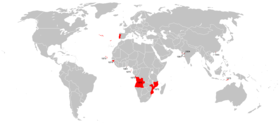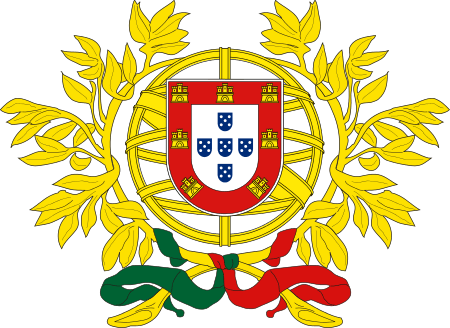Ditadura Nacional
The Ditadura Nacional (Portuguese pronunciation: [ditɐˈðuɾɐ nɐsiuˈnaɫ], National Dictatorship) was the name given to the regime that governed Portugal from 1928, after the re-election of General Óscar Carmona to the post of President, until 1933.
Portuguese Republic República Portuguesa | |||||||||
|---|---|---|---|---|---|---|---|---|---|
| 1926–1933 | |||||||||
 The Portuguese Empire during the 20th century | |||||||||
| Capital | Lisbon | ||||||||
| Common languages | Portuguese | ||||||||
| Government | Military dictatorship | ||||||||
| President | |||||||||
• 1926 | José Mendes Cabeçadas | ||||||||
• 1926–1933 | Óscar Carmona | ||||||||
| Prime Minister | |||||||||
• 1926 | José Mendes Cabeçadas | ||||||||
• 1930–1932 | Domingos Oliveira | ||||||||
| Historical era | Interwar period | ||||||||
• Established | 29 May 1926 | ||||||||
| March 19 1933 | |||||||||
| Area | |||||||||
| 1930 | 92,391 km2 (35,672 sq mi) | ||||||||
| Population | |||||||||
• 1930 | 6,825,883 | ||||||||
| Currency | Escudo | ||||||||
| ISO 3166 code | PT | ||||||||
| |||||||||
Part of a series on the |
|---|
| History of Portugal |
.svg.png) |
|
|
| Timeline |
|
|
The preceding period of military dictatorship that started after the 28 May 1926 coup d'état, is known as Ditadura Militar (Military Dictatorship). After adopting a new constitution in 1933, the regime changed its name to Estado Novo (New State).
The Ditadura Nacional, together with the Estado Novo, forms the historical period of the Portuguese Second Republic (1926–1974).
Ditadura Militar, 1926–1928
The military coup of May 28 seized power easily. Soon afterward, the dictatorship dissolved parliament, banned all political parties and instituted censorship. This process was plagued by instability as hardline military officers purged liberals and democrats from the institutions of the Republic. During this time no one clear leader emerged, as the dictatorship was led by a coalition of lower-rank military officers, some of whom were Integralists.[1]
After the republican Prime Minister and President of the Republic resigned on May 30, naval officer José Mendes Cabeçadas Júnior assumed both posts, but after conflicts with other coup leaders, he was forced to resign on June 17. He was replaced by General Gomes da Costa, the leader of the 28 May coup, who assumed the posts of both Prime Minister and President of the Republic. Gomes da Costa was not devoted to the establishment of a permanent military dictatorship, and as a result he was forced out on July 9 in a coup led by the unshakably authoritarian General António Óscar de Fragoso Carmona who assumed both of the highest offices of the state and seized dictatorial powers. Carmona continued as Prime Minister until April 18, 1928 but retained the post of President of the Republic until his death on April 18, 1951.
In 1927 there were several failed coup attempts from both left- and right-wing movements. On August 12, 1927 junior officers forced their way into a cabinet meeting and started shooting. The Carmona government regained control of the government and imposed stronger military discipline. However, the attackers were not severely punished and were sent to posts in Portuguese Angola.[1]
Ditadura Nacional, 1928–1933
In February 1928, the Commission for the Propaganda of the Dictatorship (Portuguese: Comissão de Propaganda da Ditadura) was created. The Police of Information of Porto and Lisbon were merged on March 17. Carmona organized a Presidential election on March 25, 1928, in which he was the only candidate. He was duly "elected" for a five-year term as president. On April 18 he appointed José Vicente de Freitas as the new Prime Minister. Antonio de Oliveira Salazar was appointed Minister of Finance for the second time on April 26. The new government came to an agreement with the Catholic Church, known as the Acordo Missionário (Missionary Agreement), giving the church special status in Portugal's colonies. The government also closed the main offices of the Portuguese Communist Party, which was reorganised the following year under Bento Gonçalves, with the creation of a net of clandestine cells to avoid the wave of detentions, reflecting the party's new illegal status. Later that year there was another failed Republican revolutionary attempt against the government.
The conflicts between the military officers and the National Catholic wing represented by Salazar increased to a point where the entire Freitas government resigned on July 8, 1929, with only Salazar keeping his ministerial post in the new cabinet of Artur Ivens Ferraz. Salazar's influence began to grow at the expense of military officers who gradually lost their political power, with Roman Catholic religious institutes again permitted in Portugal. On January 21, 1930, after a conflict with Salazar, Ferraz was replaced by General Domingos Oliveira, who allowed Salazar to play an ever increasing role in the nation's finances and politics. The Acto Colonial (Colonial Act) was published, defining the status of Portuguese colonies (Portuguese Angola, Cabinda, Portuguese Cape Verde, Portuguese Guinea, Portuguese São Tomé and Príncipe, Portuguese Mozambique, Portuguese India, Portuguese Timor and Portuguese Macau), and the fundamental principles of the new regime were presented by Salazar on the 4th anniversary of the May 28 Revolution.
By 1930 the military dictatorship had stabilized Portugal and the national leadership and state functionaries began to think about the future. The overarching question was "In what form was the dictatorship to continue?". The answer was provided by Salazar, who became Prime Minister on July 5, 1932 and in 1933 reorganized the regime as the Estado Novo. A new Constitution was approved in a referendum, defining Portugal as a Corporative, Single Party and Multi-continental country (in Europe, Africa, Asia and Oceania). The single party was the União Nacional (National Union), and a new labour code, the Estatuto do Trabalho Nacional (Code of National Labour), prohibited all free trade unions. Salazar's new regime brought in a system of censorship, and also created a political police force, the PVDE (Polícia de Vigilância e de Defesa do Estado; State Defense and Vigilance Police).


.png)